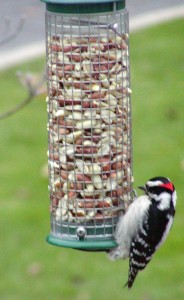
We give-away our thanks to the earth which gives us our home.
We give-away our thanks to the rivers and lakes which give-away their water.
We give-away our thanks to the trees which give-away fruit and nuts.
We give-away our thanks to the wind which brings rain to water the plants.
We give-away our thanks to the sun who gives-away warmth and light.
All beings on earth: the trees, the animals, the wind and the rivers give-away to one another so all is in balance.
We give-away our promise to begin to learn how to stay in balance with all the earth. – Iroquois Prayer (adapted)
All posts by laurahinnj
Kitchen chaos
 The kitchen looks something like this – like a small tornado hit – you get the idea – but there’s a pumpkin-praline pie baking in the oven and a pumpkin cheesecake still to make. The DH is peeling chestnuts for our favorite casserole with Brussels Sprouts. The bunnies are attention-deprived. I’m feeling thankful that I don’t have a turkey to cook also.
The kitchen looks something like this – like a small tornado hit – you get the idea – but there’s a pumpkin-praline pie baking in the oven and a pumpkin cheesecake still to make. The DH is peeling chestnuts for our favorite casserole with Brussels Sprouts. The bunnies are attention-deprived. I’m feeling thankful that I don’t have a turkey to cook also.
Happy Thanksgiving to all. Off to attend to that pie in the oven.
Alav hashalom
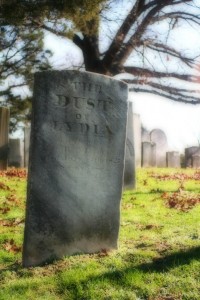 I found myself wandering around an old cemetery today on my lunch hour. I had gone intending to take some photos of Old Tennent Church, founded in 1692 and used as a temporary field hospital during the Revolutionary War. Instead I wandered around looking at the gravestones, many of which are from the 1700’s. The church building was closed, but some of the pews are said to be scarred from the surgeon’s saws and the blood of soldiers who died here during the Battle of Monmouth and are buried in the churchyard. There are two huge old oak trees that frame the entrance to the church, set on a hill.
I found myself wandering around an old cemetery today on my lunch hour. I had gone intending to take some photos of Old Tennent Church, founded in 1692 and used as a temporary field hospital during the Revolutionary War. Instead I wandered around looking at the gravestones, many of which are from the 1700’s. The church building was closed, but some of the pews are said to be scarred from the surgeon’s saws and the blood of soldiers who died here during the Battle of Monmouth and are buried in the churchyard. There are two huge old oak trees that frame the entrance to the church, set on a hill.
It felt strange to be taking photos of gravestones, but many of them are interesting. The oldest are so simple and different in their sentiments on death compared to the laser-carved ones that are seen in the modern part of the cemetery. The modern versions seem to be more about comfort and a sense of prestige for the living, rather than a memorial for the deceased. The oldest tombstones are frightening in the images they depict and the warnings they contain to passerby. A popular epitaph from the 18th century reads, “Behold and see as you pass by, as you are now so once was I, as I am now so must you be, Prepare for death and follow me.”
This curiosity about gravestones and cemeteries comes in part from thinking about them the past few days. I’m wondering what role they play in the mourning process for the people left behind. My closest friend, who lost her dad in the last year, had the *unveiling* ceremony for her dad’s monument this past weekend. It’s the custom in the Jewish religion to hold this ceremony close to the one year anniversary of a person’s death. I guess it’s supposed to be one of the last steps on the path of grief for her. I’ve tried to be with her as she learns her way without her dad beside her. I’ve tried to give her the chance to talk often of her dad and share her grief with someone who understands it, but it’s been hard to see her suffering the most personal loss of her life and not be able to do more than listen.
I hope that she’ll continue to find strength in the practice of her faith and in her family. I know how difficult it must have been for her to see her father’s name insribed on the gravestone. Perhaps the finality of that sight is the reason for the Jewish custom and the delay in seeing the monument. Maybe soon she’ll find a way to see beyond his death, to the impact of his life and his love, and she’ll come to understand that his values and ideals continue in her.
Decking the halls
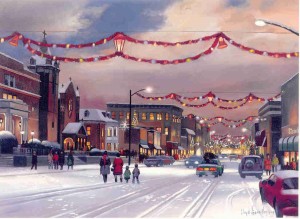
How would you like to live in a town that decks itself out like this for the holidays? Lucky me, I do! Technically, I live in the next town over, but Red Bank is the place that I consider home. I don’t really feel part of the community in the town where I live, but feel as if I’m among friends when going about my daily grind in Red Bank. There’s always a familiar face and I know the best coffee shops and where to find a good bargain in town.
My husband was born and raised in Red Bank and has worked for the Public Works Department there for most of his adult life. He fixes the police cars and fire trucks (and is a volunteer fireman there), picks up the leaves in fall, and plows the snow off the streets in the wintertime. If you want to know the truth, I think the town would crumble and fall without him, at least judging by the number of calls he gets to go into work at 3 am to fix something.
Another *job* that my DH has is to decorate the town for the holidays; he’s done this for as long as I can remember. During November he works his regular job during the day and then spends a few hours each night and most days on the weekends stringing lights and hanging wreaths around town. By the time Thanksgiving comes and the work is done he’s about had it with decorating, but that is when we start the job of decorating our own home for Christmas. Some years he’s full of energy and goes all out at home, other years we’re lucky to get a tree up and decorated before midnight on Christmas Eve.
This year, my DH decided that he wants a break and won’t be doing the decorating in Red Bank. He says he’s tired of working out in the cold and the rain. It’s strange to have him here now, when he should be out there, making the town light up so pretty. Already tonight, as the deadline nears, the phone calls are coming for him to help, or to fix some machine that’s stuck in the road blocking traffic. I’m sure he won’t be able to resist helping, for long.
The image above is a scan of a Christmas card from a few years ago. A local artist paints beautiful scenes of the town at Christmas and turns some into cards. One day I’d like to be able to afford one of his paintings of a Christmas scene of our hometown as a gift for my husband. Something beautiful to remember all of his hard work by.
Worms before dinner
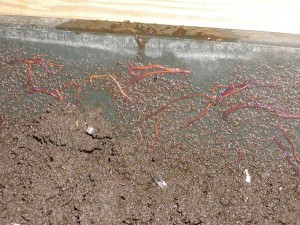 It dawned on me this afternoon that I haven’t checked on the worms in the basement for a while. I add food to the bin once a week, but lately that’s it. I’ve not been a very good landlord, it seems.
It dawned on me this afternoon that I haven’t checked on the worms in the basement for a while. I add food to the bin once a week, but lately that’s it. I’ve not been a very good landlord, it seems.
If you need reminding, I keep a worm bin in the basement to compost kitchen scraps. It’s a small tray-type bin and the worms are red wigglers. It’s not nearly as disgusting as it sounds. I collect leftover vegetables and greens, coffee grounds, and eggshells in a small copper composting bucket I keep in the kitchen and once a week empty it into the bin for the worms. I cover the food with a layer of shredded junk mail so there is no smell to attract other insects. Every few months the worms have made enough compost for me have a few cups worth of natural fertilizer for my houseplants. Mostly I save the compost up and use it in the spring when I repot.
If things are working as they should there is no smell or trouble with it at all. I usually add food to the bottom tray until it looks nearly *done* and then add food to the next tray up, with the idea that the worm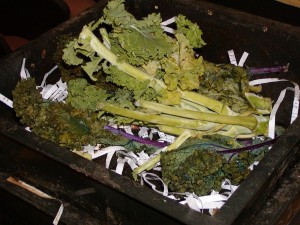 s will move upward to find the food, leaving the compost in the tray below free of worms.. My worms didn’t want to migrate upward like they were supposed to, so this year I’ve been adding food to the bottom tray, hoping that they’ll be willing instead to migrate downward. So far it seems to be working, except for the few worms in the opening photo who look like they’re trying to migrate up and out of the bin! Excess moisture has always been a problem for me and even that top tray of nearly finished compost is wetter than it should be.
s will move upward to find the food, leaving the compost in the tray below free of worms.. My worms didn’t want to migrate upward like they were supposed to, so this year I’ve been adding food to the bottom tray, hoping that they’ll be willing instead to migrate downward. So far it seems to be working, except for the few worms in the opening photo who look like they’re trying to migrate up and out of the bin! Excess moisture has always been a problem for me and even that top tray of nearly finished compost is wetter than it should be.
I suspect that adding food to the lowest tray, so near to the bottom of the set-up, is what’s causing the backup of excess moisture in the system. There’s a spigot on the bottom to drain away the liquid, so I’ve left it open with my copper bucke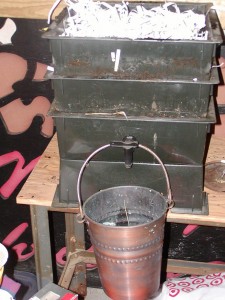 t beneath it to hopefully dry things out. They say that you should be able to use the liquid that drains out as *compost tea*, but I find it to be so foul-smelling that I would never want it on the houseplants anywhere near where I was sitting! Usually I’ll just dump it outside on the vegetable garden far away from the house.
t beneath it to hopefully dry things out. They say that you should be able to use the liquid that drains out as *compost tea*, but I find it to be so foul-smelling that I would never want it on the houseplants anywhere near where I was sitting! Usually I’ll just dump it outside on the vegetable garden far away from the house.
I decided to try adding some dry leaves as bedding, in addition to the shredded paper and junk mail, for added minerals for the worms. The instructions that came with my bin suggest adding all sorts of oddball things. Every so often I try something new and hope for the best. The worms don’t really eat the garbage; instead they feed on the microorganisms that decay the food – so I won’t add anything that is likely to rot and fester in there for too long – no meat or oil in any form. Once in a while I’ll treat them with some moldy bread or baking yeast sprinkled on top of the working tray, but that’s it. They seem to be happy with old bunny greens. In fact, I see lots of little red worms if anybody wants to give vermicomposting a try!
Carpintero velloso menor
By any other name – a bird quiz
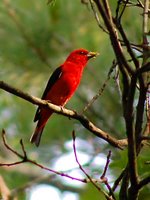 NJ Audubon has recently published a guide to the New Jersey Meadowlands that is available for free. This guide is the second in a series; the first covers the NJ Delaware Bayshore. These are great little books! I mention them now because on my most recent volunteer day at Sandy Hook Bird Observatory I discovered that the new guide had finally arrived, but for some reason, we only had the Spanish-language version in stock. While I’m glad to see that it’s being published in Spanish, I do wonder how many Spanish-speaking birders there are out there to make use of it.
NJ Audubon has recently published a guide to the New Jersey Meadowlands that is available for free. This guide is the second in a series; the first covers the NJ Delaware Bayshore. These are great little books! I mention them now because on my most recent volunteer day at Sandy Hook Bird Observatory I discovered that the new guide had finally arrived, but for some reason, we only had the Spanish-language version in stock. While I’m glad to see that it’s being published in Spanish, I do wonder how many Spanish-speaking birders there are out there to make use of it.
The language teacher and word-lover in me was most interested in how the translators of the guide handled the use of bird names in Spanish. From the little bit that I’ve read on the subject, there currently is no standard method for this type of translation due to the many local variants that are commonly used for bird names. I believe that this guide makes use of the names used in the Spanish version of the Kaufman Field Guide to Birds.
Anyway…. I thought we might have a little fun with this. Translation is more art than science, and involves finding the essence of what a thing is, rather than focusing on the words used to describe it. In other words, a thing is what it is, rather than what it’s called. Many bird names in English seem arbitrary on the surface, but often relate to some characteristic of the bird in question, whether the name be related to how the bird looks or how it feeds or the sound of its voice. For example, the name of the White-breasted Nuthatch describes the bird’s physical appearance as well as making reference to its feeding behavior. The name of the Northern Cardinal likens its color to the vestments worn by some priests. The name of the Scarlet Tanager in part is descriptive of the bird’s color, but what does tanager refer to? Is that an arbitrary term? Couldn’t we just as easily call the Scarlet Tanager the Black-winged Redbird? Would we still know it by that name?
Never having had occasion to use Spanish bird names, I sat down with my dictionary this evening to dissect the Spanish names of a few birds and thought it might make a fun quiz for bird lovers. The 15 bird names that follow are literal translations of the Spanish used to describe them. Similar species are loosely grouped together.
1. Scratching sparrow
2. Chestnut-colored pouch-maker
3. Red-eyed scratcher
4. Fuzzy little carpenter
5. Little whistling plover
6. Orange-throated warbler
7. Blazing/fluttering warbler
8. Sideburned warbler
9. Ground warbler
10. Creeping warbler
11. Spotted thrush
12. Golden-toed egret
13. Scissor-tailed swallow
14. Rainbow duck
15. Nun-like duck
Some of these are very easy, with others you may have to use your imagination. Some bird names were impossible to translate so literally without giving them away, often because the name, like our English one, related to the bird’s call. For example, the Killdeer is called Chorlo Tildío; Chorlo is the family name of Plover, Tildío is the descriptive term and sounds (even in Spanish!) like the Killdeer’s call. Similarly, the Willet is called Playero Pihuihui; Playero is the family name and Pihuihui describes the Willet’s call.
Happy guessing!
Image of the Black-winged Redbird from http://www.flickr.com/photos/trombamarina/179428016/
11/16/06 Mid-week bunny fix
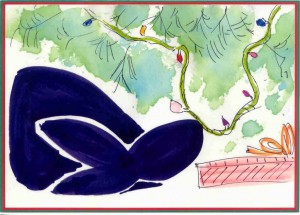 Just passing along a link to a favorite bunny site this week. If you’re looking for bunny-themed holiday cards or what-have-you check out Rabbitt in Paradise. Blackberry Bunny lives at the beach in Hawaii.
Just passing along a link to a favorite bunny site this week. If you’re looking for bunny-themed holiday cards or what-have-you check out Rabbitt in Paradise. Blackberry Bunny lives at the beach in Hawaii. Friends and companions (Renga)
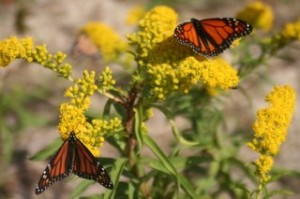
urgency of bloom
hurry to flower and seed
fuel for the migrants
Autumn’s children moving south
in flocks like sunset-colored clouds
A rather loose interpretation of this week’s theme for one deep breath. A Renga is a group-effort sort of poem, written with others. I may try to get the girls at work to help me on another one, like Jane Poe – Nevermore did. Stay tuned.
**Updated: I harassed some of my coworkers into writing a Renga today, as stress relief. Their group effort follows.
In other news, my big brother stopped by here long enough to razz me about being Daddy’s Little Girl. Check the comments on this post.
Honey, I think it’s done
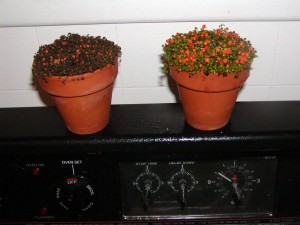 We had my favorite for dinner on Sunday night – Spaghetti! Pasta is more or less a forbidden food here since my husband found out a few years ago that he has diabetes. I love pasta and bread more than anything, except cheese, and miss eating it. I hardly ever get to have it for lunch even, because my lunch-buddy Deb makes me eat healthy salads everyday.
We had my favorite for dinner on Sunday night – Spaghetti! Pasta is more or less a forbidden food here since my husband found out a few years ago that he has diabetes. I love pasta and bread more than anything, except cheese, and miss eating it. I hardly ever get to have it for lunch even, because my lunch-buddy Deb makes me eat healthy salads everyday.
We decided to cheat, just once, because I was craving Spaghetti. I was totally decadent and bought nice Italian bread and whole milk ricotta cheese to mix with the pasta. Heavenly!
The DH ended up in charge of cooking while I wandered off to do something else. While I was cleaning up the dishes and stove I discovered the poor charred houseplants that I had left on top of the stove to drain. The one on the right is more or less okay, just a little singed around the edges, but the other is totally baked. I wonder, do you think it will recover? 😉
If you’re interested, the plant is called a Pin Cushion Plant or Coral Bead Plant (Nertera granadensis) and is a weird little houseplant in the madder family sold around Halloween. I read that it’s native to moist, boggy places in New Zealand and Tasmania. Apparently, it doesn’t do well on the stove, despite all the steam from the boiling pasta.
